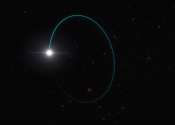Study investigates a massive 'spider' pulsar
Astronomers from the Stanford University in California have performed joint X-ray and optical observations of a massive "spider" pulsar designated PSR J2215+5135. Results of the observational campaign, presented in a paper ...









